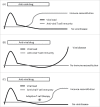Immunotherapy for opportunistic infections: Current status and future perspectives
- PMID: 27385102
- PMCID: PMC5160405
- DOI: 10.1080/21505594.2016.1207038
Immunotherapy for opportunistic infections: Current status and future perspectives
Abstract
The outcome after allogeneic haematopoietic stem cell transplantation (allo-HSCT) has significantly improved during the last decades. However, opportunistic infections such as viral and mold infections are still a major obstacle for cure. Within this field, adoptive T cell therapy against pathogens is a promising treatment approach. Recently, the techniques to develop T cell products including pathogen-specific T cells have been sophisticated and are now available in accordance to good manufacturing practice (GMP). Here, we aim to summarize current knowledge about adoptive T cell therapy against viral and mold infections.
Keywords: adoptive immunotherapy; aspergillus; mold infection; viral infection.
Figures


Similar articles
-
Cytomegalovirus disease in hematopoietic stem cell transplant patients: current and future therapeutic options.Curr Opin Infect Dis. 2017 Aug;30(4):372-376. doi: 10.1097/QCO.0000000000000375. Curr Opin Infect Dis. 2017. PMID: 28505028 Review.
-
Moving Past Ganciclovir and Foscarnet: Advances in CMV Therapy.Curr Hematol Malig Rep. 2020 Apr;15(2):90-102. doi: 10.1007/s11899-020-00557-6. Curr Hematol Malig Rep. 2020. PMID: 31981100 Free PMC article. Review.
-
Adoptive T-cell transfer for refractory viral infections with cytomegalovirus, Epstein-Barr virus or adenovirus after allogeneic stem cell transplantation.Klin Padiatr. 2013 May;225(3):164-9. doi: 10.1055/s-0033-1333749. Epub 2013 May 22. Klin Padiatr. 2013. PMID: 23700092
-
Innovative approaches of adoptive immune cell therapy in paediatric recipients of haematopoietic stem cell transplantation.Best Pract Res Clin Haematol. 2004 Sep;17(3):479-92. doi: 10.1016/j.beha.2004.06.0054. Best Pract Res Clin Haematol. 2004. PMID: 15498718 Review.
-
Cellular therapy for multiple pathogen infections after hematopoietic stem cell transplant.Cytotherapy. 2017 Nov;19(11):1284-1301. doi: 10.1016/j.jcyt.2017.07.012. Epub 2017 Sep 15. Cytotherapy. 2017. PMID: 28927824 Review.
Cited by
-
Use of Specific T Lymphocytes in Treating Cytomegalovirus Infection in Hematopoietic Cell Transplant Recipients: A Systematic Review.Pharmaceutics. 2024 Oct 11;16(10):1321. doi: 10.3390/pharmaceutics16101321. Pharmaceutics. 2024. PMID: 39458650 Free PMC article. Review.
-
Infections following allogeneic stem cell transplantation: New concepts, improved insights, and renewed hope for better outcomes.Virulence. 2016 Nov 16;7(8):898-900. doi: 10.1080/21505594.2016.1252019. Virulence. 2016. PMID: 27791470 Free PMC article. No abstract available.
-
Robust Identification of Suitable T-Cell Subsets for Personalized CMV-Specific T-Cell Immunotherapy Using CD45RA and CD62L Microbeads.Int J Mol Sci. 2019 Mar 20;20(6):1415. doi: 10.3390/ijms20061415. Int J Mol Sci. 2019. PMID: 30897843 Free PMC article.
-
Cytomegalovirus Infections after Hematopoietic Stem Cell Transplantation: Current Status and Future Immunotherapy.Int J Mol Sci. 2019 May 30;20(11):2666. doi: 10.3390/ijms20112666. Int J Mol Sci. 2019. PMID: 31151230 Free PMC article. Review.
-
Recent Advances in the Treatment of Scedosporiosis and Fusariosis.J Fungi (Basel). 2018 Jun 18;4(2):73. doi: 10.3390/jof4020073. J Fungi (Basel). 2018. PMID: 29912161 Free PMC article. Review.
References
-
- Gooley TA, Chien JW, Pergam SA, Hingorani S, Sorror ML, Boeckh M, Martin PJ, Sandmaier BM, Marr KA, Appelbaum FR, et al.. Reduced mortality after allogeneic hematopoietic-cell transplantation. N Engl J Med 2010; 363:2091-101; PMID:21105791; http://dx.doi.org/10.1056/NEJMoa1004383 - DOI - PMC - PubMed
-
- Afessa B, Peters SG. Major complications following hematopoietic stem cell transplantation. Semin Respir Crit Care Med 2006; 27:297-309; PMID:16791762; http://dx.doi.org/10.1055/s-2006-945530 - DOI - PubMed
-
- Gratwohl A, Brand R, Frassoni F, Rocha V, Niederwieser D, Reusser P, et al.. Cause of death after allogeneic haematopoietic stem cell transplantation (HSCT) in early leukaemias: an EBMT analysis of lethal infectious complications and changes over calendar time. Bone Marrow Transplant 2005; 36:757-69; PMID:16151426; http://dx.doi.org/10.1038/sj.bmt.1705140 - DOI - PubMed
-
- Styczynski J, Czyzewski K, Wysocki M, Gryniewicz-Kwiatkowska O, Kolodziejczyk-Gietka A, Salamonowicz M, Hutnik L, Zajac-Spychala O, Zaucha-Prazmo A, Chelmecka-Wiktorczyk L, et al.. Increased risk of infections and infection-related mortality in children undergoing haematopoietic stem cell transplantation compared to conventional anticancer therapy: a multicentre nationwide study. Clin Microbiol Infect 2016; 22:179 e1-e10; PMID:26493843; http://dx.doi.org/10.1016/j.cmi.2015.10.017 - DOI - PubMed
-
- Crocchiolo R, Bramanti S, Vai A, Sarina B, Mineri R, Casari E, Tordato F, Mauro E, Timofeeva I, Lugli E, et al.. Infections after T-replete haploidentical transplantation and high-dose cyclophosphamide as graft-vs.-host disease prophylaxis. Transpl Infect Dis 2015; 17:242-9; PMID:25648539; http://dx.doi.org/10.1111/tid.12365 - DOI - PMC - PubMed
Publication types
MeSH terms
LinkOut - more resources
Full Text Sources
Other Literature Sources
